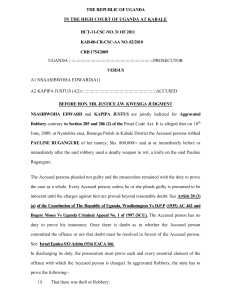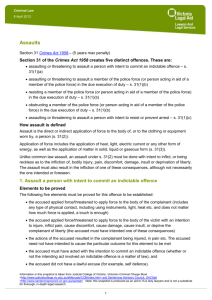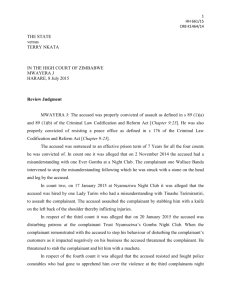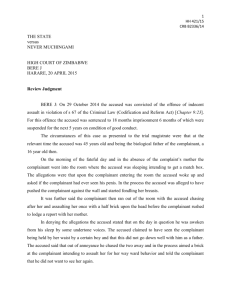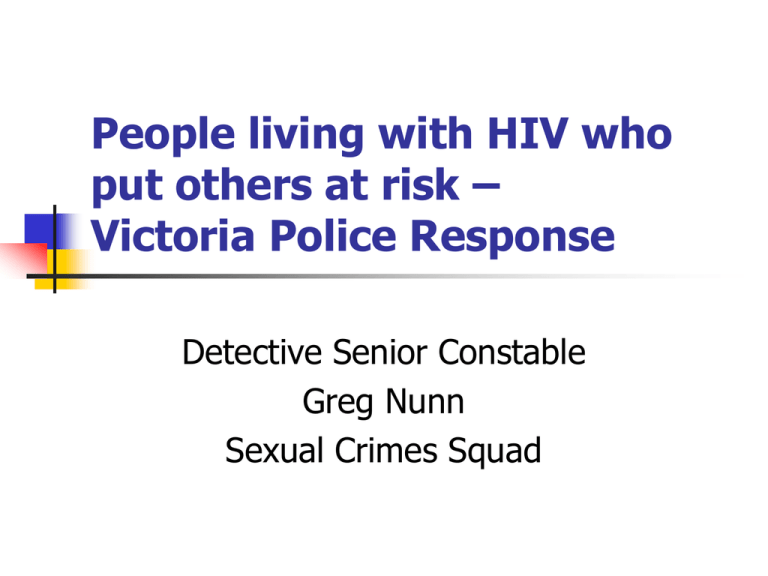
People living with HIV who
put others at risk –
Victoria Police Response
Detective Senior Constable
Greg Nunn
Sexual Crimes Squad
Notification to police
Calls to Crimestoppers (sometimes
anonymous)
Reports made by members of the public
directly to a local police station or the
Sexual Crimes Squad
Notifications via the Department of
Health (DH)
Police / Dept. Health Protocols
Police acknowledge that pursuant to the
Public Health and Wellbeing Act 2008,
the vast majority of persons with HIV
who appear to be placing others at risk
can be, and are, appropriately managed
under the PH&W act by the Dept.
Health (from the MOU dated
11/05/2012)
Notifications – the MOU
Police will notify Dept. Health of ALL
cases involving a person who appears
to be placing others at risk of HIV
infection
Dept. Health may at it’s discretion,
notify police of any case at any time,
and will notify police of any serious
crime.
When police receive a notification
Liaise with the DH to obtain basic
information and confirm the HIV status
of the person/s involved in accordance
with the Information Privacy Act 2001
Arrange to meet the complainant and
take a formal statement
The police statement
The whole story surrounding the
‘relationship’ between the complainant
and the accused
Any discussion about HIV status prior to
sex
The exact nature of the sex –
insertive/penetrative, condoms,
ejaculation, bleeding, risk factors such as
piercings, sores etc.
The complainant would not have had
unprotected sex had he/she known the
accused was HIV positive – they didn’t
knowingly accept the risk
The police statement
The information provided by a
complainant may be extremely personal
and confidentiality is critical
Police will comply with the Information
Privacy Act 2001 and the Health Privacy
Principles re the disclosure of a person’s
HIV status
The statement will be taken by a detective
from the Sexual Crimes Squad or a local
Sex Offence and Child Abuse Investigation
Team
Statements
Eliminate
other possible sources of
transmission – e.g. discuss any
intravenous drug use, obtain details
of other sex partners and obtain
statements as to their HIV status
Establish what crimes have been
committed – The Crimes Act
Reckless Conduct Endangering Serious
Injury – maximum 5 years jail
Reckless Conduct Endangering Life – 10
years – case law – the threat of death is not
immediate
Recklessly cause serious injury – 15 years
Recklessness
Conduct is reckless if there is foresight on
the part of the accused of the probable
consequence of his actions and he displays
indifference as to whether or not those
consequences occur – R v. Nuri [1990] VR
641
The risk
There must be ‘appreciable’ risk
There’s no legislated definition of ‘appreciable’ – it’s
up to the reasonable man test – left for a jury to
decide
The chance of HIV transmission per episode of
unprotected anal intercourse is estimated at between 1/120 and 1/300 for the receptive partner
1/1000 for the insertive partner
1/1000 for penis/vagina sex
County Court trial analogy re ‘risk’
The risk
Use of condoms reduces the risk of
transmission to a level where the risk of
transmission is not usually considered
‘appreciable,’ therefore there would be no
criminal offence detected
Crimes Act offences (cont.)
Intentionally cause serious injury - 20 years
Procure sexual penetration by fraud – 5
years
Rape - e.g – where there is no consent or
consent is withdrawn – 25 years
Crimes Act offences (cont.)
Intentionally Cause a Very Serious Disease
(defined in the act as HIV) 25 years jail
Attempt to Intentionally Cause a Very Serious
Disease – 20 years jail
Intent to infect
The reporting of these types of cases to
police is rare
Evidence will be required to show the
accused intended to infect the complainant
Canvass possible defences
‘I didn’t know I was HIV positive.’
‘I’ve never met that person.’
‘My viral load was undetectable .. I can’t
infect anyone.’
‘ I always use condoms.’
‘ I told him I was HIV positive’
‘ I was drunk, I can’t remember.’
‘There’s no such thing a the HI virus’
Documentary Evidence
DH records obtained under a court issued
search warrant may include partner
notification office records, dates of infection,
viral loads, copies of documents served on
the accused such as written warnings and
Health Orders
GP/psychologists notes under search
warrant
The Victorian Infectious Diseases
Reference Laboratory
VIDRL testing to compare the relatedness of
the HIV strains between the accused and the
complainant
100
80
60
ACCUSED
VICTIM 1
VICTIM 2
40
Controls
20
Controls
0
Controls
ANOTHER
POSSIBILITY
Accused
HAS SEX
WITH
AND
INFECTS
VIDRL RESULT COULD STILL
SHOW 100% RELATEDNESS TO
THE ACCUSED, THEREFORE WE
CANNOT RELY ON THE VIDRL
TEST TO PROVE THAT THE
ACCUSED INFECTED VICTIM 1.
VICTIM 1
WHO HAS
SEX WITH
AND
INFECTS
BILLY BLOGGS
Other avenues of enquiry prior
to arrest
Electronic surveillance such as
telephone intercepts, listening devices
Physical surveillance
Profiling of suspect
Interview and arrest planning
Corroborate the complainant statement
Expert evidence – epidemiologists,
VIDRL
Arrest and Interview
The accused is asked to ‘tell us all about your
relationship with …..’
The allegations/evidence are put to the
accused
A decision to either charge the accused or
proceed by way of summons, depending on
the evidence
If charged, the accused may be brought
before a magistrate for a remand application.
None of these offences constitute a ‘show
cause’ situation
Court
Reckless conduct matters may be heard in
the Magistrates Court
Intentionally cause serious injury/disease
must go for trial at the County Court
Police will take steps to care for the witnesses
privacy – suppression orders, closed courts,
remote witness facilities
After conviction, the complainant may tender
a ‘victim impact statement’ to the court
The OPP, W.A.S. and VOCAT applications
Court
Male convicted of attempting to intentionally
infect 2 persons – 8 years jail for each
offence, 6 years 6 months concurrent
He was also convicted of 3 counts of reckless
conduct endangering serious injury involving
3 other persons - 2 years jail on each count
Total sentence 14 years jail with a 9 year
non-parole period









